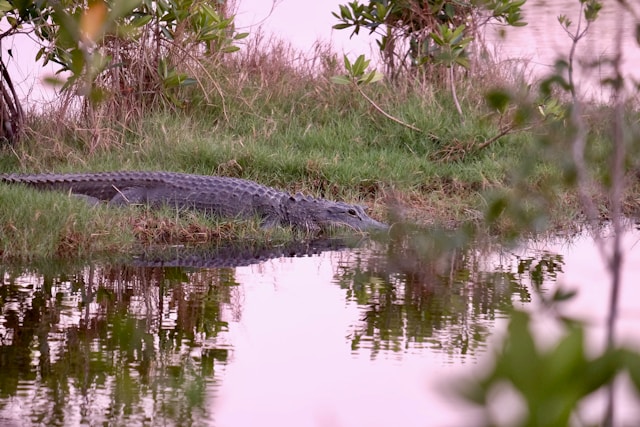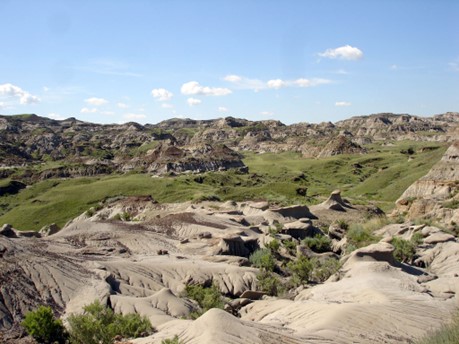Celebrating America’s Natural Heritage – Part I: A century-long restoration project
Since the creation of Yellowstone as the world’s first national park in 1872, natural and cultural heritage protection has significantly progressed across North America.

Throughout 2024, the IUCN North America Regional Office will put the spotlight on four natural wonders which celebrate their 45th World Heritage anniversary this year: Dinosaur Provincial Park, Everglades National Park, Grand Canyon National Park, and Kluane / Wrangell-St. Elias / Glacier Bay / Tatshenshini-Alsek.

© NPS Photo
Everglades National Park is the largest designated sub-tropical wilderness reserve on the North American continent. It contains the largest mangrove ecosystem in the Western Hemisphere, the largest continuous stand of sawgrass prairie and the most significant breeding ground for wading birds in North America. Florida’s only World Heritage site provides refuge for over 20 rare, endangered, and threatened species such as the Florida panther, snail kite, alligator, crocodile, and manatee. Conservationist Marjory Stoneman Douglas aptly described the Everglades as “A river of grass”. The Everglades National Park is managed by the National Park Service, a long-standing IUCN member.
In 1979 IUCN recommended the inscription of the Everglades on the World Heritage List, arguing how that would enhance action for the ongoing restoration activities. Decades earlier, wardens were still killed by flamingo poachers, herons were a rare sight, and many considered the Everglades a “worthless swamp”. But ever since the creation of the Everglades National Park in 1947, things had slowly started to change.
In 1989, IUCN highlighted increasing evidence that the major wetlands system of the Everglades was under considerable threat due to urbanisation and agriculture. Following the damage from Hurricane Andrew in 1993, IUCN suggested that the Everglades should be inscribed on the List of World Heritage in Danger.
During the next 15 years, the US significantly stepped-up funding for a long-term restoration plan to “get the water right”. Federal agencies as well as state and local governments came together in a collaborative effort to protect this unique ecosystem by restoring the water flows that are necessary to keep the marshes and Florida Bay healthy. IUCN was invited to monitor and assess the results of the restorative efforts.
In 2000 the US adopted the Comprehensive Everglades Restoration Plan (CERP), the world’s largest environmental restoration project which aimed to re-establish natural water flows to the greater Everglades ecosystem. The plan was projected to take 30-40 years and estimated at USD 10.5 billion.
In recognition of the considerable efforts and investments made in the restoration and conservation of the Everglades, the World Heritage Committee decided to remove the site from the List of World Heritage in Danger in 2007. However, in 2010 the US requested the Everglades be re-inscribed on the Danger List, because the restoration goals for increased water quantity and flow were not yet realised. IUCN and UNESCO were invited to visit the Everglades and worked with authorities to develop an updated action plan with measurable targets and indicators.
Over the years, IUCN members have provided substantial support to protect this unique World Heritage site. Light Hawk Conservation Flying has supported wildlife assessments through aerial surveys conducted by volunteer pilots. Meanwhile organizations such as the Center for Biological Diversity set up campaigns to stop oil-drilling in and near the vicinity of the Everglades National Park.

Photo Source: 2022 State of Conservation Report for the Everglades
From 2010 to 2024, considerable progress has been made, and several of the ecological indicators are improving or are already within their desired state of conservation. Yet sustained work is essential. The 2020 IUCN World Heritage Outlook rated the Everglades’ state of conservation as critical, and pointed to new threats such as invasive species and climate change which are making the monumental task ahead not easier.
IUCN and its members are committed to continue supporting the safeguarding of the iconic Everglades National Park, for the benefit of current and future generations of Americans.
More information about the IUCN assessments, as well as state of conservation reports from the US Government and decisions from the World Heritage Committee are available at the website of the UNESCO World Heritage Centre.
About the World Heritage Convention and IUCN
Iconic sites such as the Galápagos Islands, the pyramids of Egypt, the medieval city of Bruges, or the Serengeti have received the highest level of international recognition: World Heritage designation. These sites tell our shared human story. They are irreplaceable.
In 1972 the United States spearheaded the development of an international treaty called the UNESCO World Heritage Convention. IUCN – the International Union for the Conservation of Nature - co-drafted this Convention and is explicitly recognized as its technical Advisory Body on nature.
From the over 1,000 World Heritage sites internationally recognized for their cultural and natural values, 25 are located in the Unites States and 22 in Canada. Many of those sites are managed by long-standing IUCN members the National Park Service and Parks Canada / Parcs Canada.
The World Heritage team in the IUCN North America Office actively builds partnerships to support the World Heritage Convention, prioritizing those natural wonders most in need.
Contact
Robbert Casier
World Heritage Programme Development Officer
robbert.casier@iucn.org

